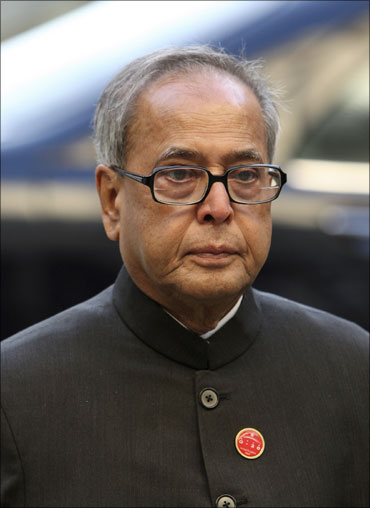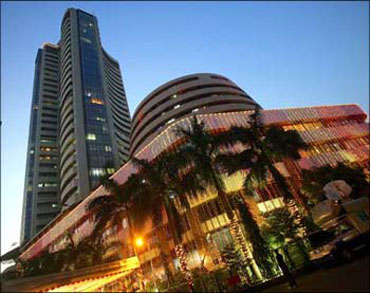 | « Back to article | Print this article |
Budget: What to expect, what not to expect
Amid speculation that taxes and duties might be raised as part of a partial rollback of the economic stimulus, Finance Minister Pranab Mukherjee will present the Budget for 2010-11 on Friday.
But Mukherjee's job is not an enviable one this time: he has his hands full. He faces a tough challenge as he has to try and present a balanced Budget; one that will appease the aam aadmi and also not hamper growth.
So what is it that you can expect from the Budget? And what should you not expect?
Things to expect
Fiscal prudence: Corrective measures to repair India's balance sheet seem imminent. The fiscal position stands stressed with a 16-year high deficit of 6.8% of GDP. With Central Statistical Organisation advance estimates hinting at a GDP growth of 7.2% for 2009-10, the government is bound to withdraw some of the stimulus doled out previously.
Click NEXT to read on. . .
Budget: What to expect, what not to expect
Things to expect
Revenue boosting measures: The government is likely to provide a roadmap for its disinvestment plan and Goods and Services Tax implementation in the budget.
The government will aim at a sizeable inflow of Rs 25,000 crore (Rs 250 billion) from disinvestment proceeds (actual conversions will depend on stock market conditions).
Direct Taxes Code: The key change on the anvil is the proposed Direct Taxes Code. Given that the code aims to moderate tax rates, widen the tax base, and remove exemptions, it will have positive impact on government revenues.
Goods & Services Tax: On the indirect tax front, the much-anticipated reform measure is the introduction of a uniform Goods and Service Tax (GST).
Although the deadline for implementation is likely to be missed, the government appears keen on introducing the GST regime. The shift to GST is expected to significantly improve buoyancy from indirect taxes.
Click NEXT to read on. . .
Budget: What to expect, what not to expect
Things to expect
Divestment: Late last year, the government announced measures that would give a significant boost to the disinvestment program. It is now mandatory for all profitable listed public sector enterprises to have minimum 10% public ownership.
While the government has already divested its stake in NHPC, Oil India and NTPC, many more are likely to follow in the coming year.
Infrastructure development: Infrastructure development momentum will continue with flagship programmes like Bharat Nirman and JNNURM set to witness significant rise in allocations.
The potential reform areas may include transparency in Public Private Partnership (PPP) project bids, land issues and the green signal to long-term bank finance for infrastructure.
Other moves could include positive steps for affordable housing, a rise in National Highway Authority of India budgetary support besides national project status for certain state irrigation projects.
Click NEXT to read on. . .
Budget: What to expect, what not to expect
Things to expect
Rural reforms: The United Progressive Alliance agenda of inclusive growth is expected to translate into key steps for rural development. The estimated 0.2% decline in farm output for 2009-10 makes this initiative even more critical.
While allocations to the flagship programmes will continue, the NREGA may not win large allocations, as the government would probably give priority to curb leakages and inefficient resources.
Pro-education norms: Substantial increase in both primary as well as secondary education allocations is expected. The new fundamental Right to Education between 6 to 14 years of age could be the focal point of reform. The Sarva Siksha Abhiyan may also get a boost.
Click NEXT to read on. . .
Budget: What to expect, what not to expect
Things not to expect
No sector specific tax breaks: No significant measures seem likely for exports and the information technology sector. The government would prefer to wait and watch on how the global economy fares in the coming time.
No major announcement on subsidies: The finance minister may choose, to keep key policy announcements on subsidies outside the budget, but the direction to the forthcoming policies will have to be laid out in the budget.
The government's policy on fertilisers that was announced just days ahead of the budget, has given some sense of how fertiliser subsidies will be pruned as the government moves towards a nutrient based fertiliser subsidy regime.
In the same way, the government's numbers on fuel subsidies put out in the budget document will throw some hints as to which way the fuel policy will go.
Click NEXT to read on. . .
Budget: What to expect, what not to expect
Things not to expect
Income tax
Direct tax rates unlikely to be changed substantially: Mirroring the slowdown in economic growth, growth of direct tax collections slowed substantially in 2008-09 and clocked a low 8.5% growth in April-December 2009.
With collections at Rs 250,000 crore (Rs 2.5 trillion) at the end of December 2009, the 2009-10 Budget Estimate of Rs 370,000 crore (Rs 3.7 trillion) is likely to be met although collections may fall substantially short of the revised target of Rs 400,000 crore (Rs 4 trillion).
In view of the new direct taxes code to be implemented with effect from April 1, 2011, Budget 2010-11 is unlikely to introduce any major changes with regards to direct taxes.





